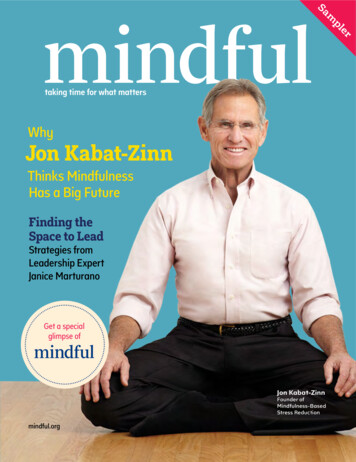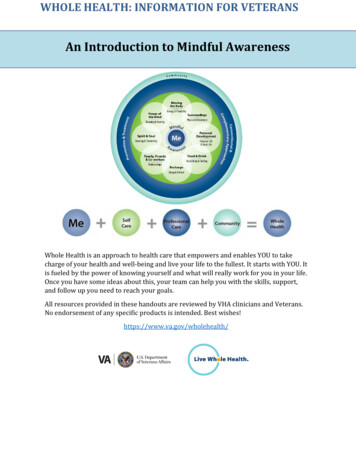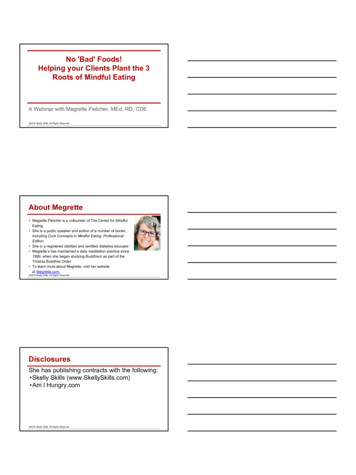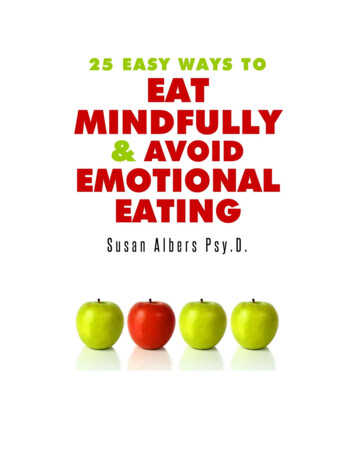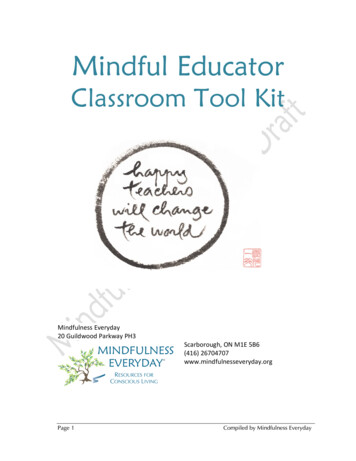
Transcription
Mindful EducatorClassroom Tool KitMindfulness Everyday20 Guildwood Parkway PH3Page 1Scarborough, ON M1E 5B6(416) 26704707www.mindfulnesseveryday.orgCompiled by Mindfulness Everyday
Mindful Educator Tool Kit for the ClassroomMindful Educator - Skill for being with the Ups and Downs of LifeCurriculum AuthorsSusan HuttonHeidi BornsteinSara EscottManaging EditorHeidi BornsteinDesign & ProductionHeidi BornsteinSeptember 2015All content is protected by copyright Mindfulness Everyday Redistribution, replication or commercial use is prohibitedwithout expressed written permission of Mindfulness Everydaywho is the sole owner and copyright holder of this property.For more information on educational programs and materials,please contact us at info@mindfulnesseveryday.orgMindful Educator provides Stress Management & Resilience Techniquesfor educators and helping professionals,based on the principles of the MBSR (Mindfulness-Based Stress Reduction) Workshop programcreated by Jon Kabat-Zinnat the University of Massachusetts Medical Centre in 1979.Mindfulness Everyday is a registered Canadian charity.Page 2Compiled by Mindfulness Everyday
MINDFUL EDUCATOR TOOL KITMINDFUL EDUCATOR TOOL KIT2WHAT IS MINDFULNESS?4Mindfulness for Classrooms51.MINDFULNESS BELL72.ABCD PRACTICE73.CALM DOWN JAR84.MINDFUL FEELINGS JAR85.DRAWING THE BREATH ART ACTIVITY96.BREATHING BUDDIES97.GRATITUDE ACTIVITY98.INFINITY SYMBOL BREATHING109.LABYRINTH FINGER TRACING1010.FIVE FINGER BREATHING1111.HOBERMAN SPHERE1112.SLINKY BREATHING1213.MINDFULNESS THUMB BALL1214.EMOTION THUMB BALL1215.Alphabreaths1216.BREATH VISUALIZATION13Rose and Dandelion Visualization:13Hot Chocolate Breath:13Shark Fin Breath:13Tree Breath:1317.Mindfulness Cards1418.Yoga and Mindfulness Cards1419.Mindfulness Activity Task Cards (free download)1420.MINDFUL EATING1521.BODY SCAN VISUALIZATION1522.MANAGING TEST ANXIETY1623.RESOURCES17Free Apps (with guided practices):17Page 2Compiled by Mindfulness Everyday
Books for Educators:17Books for Kids:1724.Finger Labyrinth Sheet1825.Thoughts are Not Facts (Infographic)1926.7 Things Mindful People Do Differently (Infographic)2027.A Mindful S.N.A.C.K. (Infographic)2128.THINK before you . (Infographic)2229.Mindful Listening (infographic)2330.5 4 3 2 1 Grounding Technique24Page 3Compiled by Mindfulness Everyday
WHAT IS MINDFULNESS?Mindfulness is paying attentionto your life, in the here and now,with kindness and curiosity,so that you can choose your behaviour.Amy Saltzman, M.D.Page 4Compiled by Mindfulness Everyday
Mindfulness for ClassroomsMindfulness can be fun! It is not an add-on. Here you will find inclusive ways to bringMindfulness practice into your life. This is a tool kit if you will, of all ages Mindfulnesspractices.Please adapt and make them your own, in a way that suits your classroom.Bring Mindfulness to all of your life with your students. Mindfulness with students is anevidence-based approach that Strengthens self-control Improves Health and Body Image Lowers anxiety and stress Improves Emotional Regulation Skills Increases positive moods Improves social skills andcommunication Better decision making Increases self-esteemRemember the key is to take care of yourself first, putting the oxygen mask on yourself,before embarking on helping anyone else.Simply pay attention to yourself, noticing body sensations, thoughts and emotions, andPAUSE before reacting. It is simple and yet not easy, a skill developed with practice overtime.MINDFUL EDUCATOR SELF CARE TIPS Be present (Are you remembering something about the past or worrying aboutsomething in the future? What is happening RIGHT HERE RIGHT NOW)Practice compassion (For yourself, children and others)Beware of thoughts (Thoughts are not always facts)Acknowledge what you are feeling - Emotions (Name it to tame it)Be aware of your breath (Long slow breathing with an emphasis on the exhalationrelaxes the body)Be aware of your body (Grounding - befriend gravity)Accept things as they are (Respond vs react – it is what it is)Be mindful of technology (Turn it off, all of it, sometimes)Acknowledge transitions - Transitions are the spaces between moments. Transitionsare not just about just getting you ready for the next experience, they are theexperience.Page 5Compiled by Mindfulness Everyday
MINDFULNESS TOOL KITCreate a container for your classrooms to keep mindful reminders for your students, thatcan be used to imbed mindfulness into what you are already doing. A mindfulness box canhold things such as: A mindfulness bell used to bring attention to the present moment Breathing buddy – Stuffed animals to practice breathing with Calm Down Jar – Mind In A Jar Colouring pages and coloured pencils / markers Emotion Thumb Ball Finger labyrinth image sheet Gratitude jar and paper to write what you are grateful for Hoberman sphere or slinky to be used for demonstrating breathing in and breathing out Make your own stress ball instructions Mindful eating instructions Mindful feelings jar filled with feelings written on them Mindful Yoga cards to practice stretching and mindful movements Mindfulness Activity Sheets Mindfulness books Mindfulness cards Mindfulness thumb ball Squishy ballsPage 6Compiled by Mindfulness Everyday
1. MINDFULNESS BELL When it is rung, everyone in the class stops what they aredoing and listens to the bell, until they can no longer hear theresonance of the bell. When you can’t hear the bell, stretch (either standing upor in your chair). Then, just feel your breath in your body, allowing the bodyto relax, as best you can, and just feel the sensations in the present moment.It takes a while to get everyone into the flow of the Mindful Bell, so be patient.Just having the bell in the room can be a reminder for the class to be more mindful. Youcan invite a student to lead the Mindful Bell practice.Vibratone: Latin Percussion LP775-BL Vibra-Tone Std.Indigo Blue http://bit.ly/MEvibratone*NOTE: the mindfulness bell is used to help Pay Attentionnot get attention.2. ABCD PRACTICEA Anchor your attention to the present moment. For example, have your feet be theanchorB Breath and notice the quality of your breath; Shallow? Full? Fast? Slow? Chest? Belly?C Check in with yourself as if you were checking in with a good friend. How are youmentally? emotionally? physically?D Decide what you need right now? A glass of water? A deeper breath? To sitdown? To move around?*The ABCD Practice was created by Sara Escott as part of hermindfulness and drama in school program for elementary students.Page 7Compiled by Mindfulness Everyday
3. CALM DOWN JARThis activity is sometimes referred to as "Mind in a Jar" because the water signifies ourmind and the glitter our thoughts and feelings. When the water is calm it is clear, muchlike our mind is clear when our thoughts and feelings are calm. When something happensthat causes our thoughts and feelings to swirl around, even just a little, we cannot seequite as clearly. And when the mind is very active, we can't see (through the bottle) at all.If we needed to make a decision or respond thoughtfully to someone, we would be verychallenged to do so until we were able to calm our mind and see clearly.It is important for students to understand that our thoughts and feelings are not bad,even when they are upsetting - they are a part of what makes us who we are. Mindfulnessteaches us to grow in our awareness of our internal and external states; to be curious ofour thoughts and feelings, and learn to sit with them even when they are uncomfortable.CALM DOWN JAR MATERIALS Small jar: make sure it’s one that will close tightly to hold liquid1 tube of glitter glueLiquid SoapWaterThis is pretty simple: just add everything to the jar. Use warm water and give it a goodshake to get the glue mixed in well. Bring on the peace! You may wish to use glue to sealthe jar.4. MINDFUL FEELINGS JARIt’s good to help students identify feelings in their body andbuild confidence in being with them. After we becomefamiliar with the sensations in the body associated withemotions and learn to accept them, feelings aren’t so scary.Having a jar with pieces of paper with feelings written in itgives us a chance to talk about feelings. You can sit downand look at the papers and talk about times you have feltthat emotion. You can also have some fun and play charades using the papers withemotions written on them. Research has shown that helping children develop acceptanceof their feelings is helpful in reducing anxiety.Page 8Compiled by Mindfulness Everyday
5. DRAWING THE BREATH ART ACTIVITYMaterials: Paper / Crayons or markers Pass out markers. Have everyone choose a colour to begin with. Find a starting point with eyes open on the left side of the paper. Invite everyone to close their eyes and breathe naturally, withoutchanging the breath in any way. As they breathe, draw their breath, letting your movement followthe breath. The breath is the guide and the crayon/marker follows.After a few breaths, invite everyone to open their eyes.They can then colour in any closed spaces in the abstract drawing of their breath andadd other colours to the drawing.Everyone’s breath will look different. Some many go left to right in a wave fashion rarelyoverlapping or some may spike and continuously intertwine.Encourage everyone to share what their breath looks like and discuss all the beauty intheir unique breath art.*Created by Sue Hutton, Social Worker, Mindful Parenting Teacher6. BREATHING BUDDIESFor young children, an instruction to simply “pay attention to thebreath” can be hard to follow. A “breathing buddy” exercise can bemore accessible: Each student grabs a stuffed animal, and then liesdown on their back with their buddy on their belly. They focus theirattention on the rise and fall of the stuffed animal as they breathe inand out.7. GRATITUDE ACTIVITYResearch shows that practicing the 3 E’s of Gratitude get resultsand help people improve their wellbeing. Students can keeplisting things and people they are grateful for. It doesn’t have tojust be one. Encourage them to feel what it’s like to be grateful– where in the body do they feel it.1. Exercise Gratitude: Do it everyday, just like physical exercise2. Emote Gratitude: Mindfully feel the emotions (sensations associated with gratitude)3. Express Gratitude: Tell it to people in your life, like your friends, teachers, and familyHave students write on small pieces of paper and contribute to the class Gratitude Jar.Find a special time to open the jar and share what has been written.Page 9Compiled by Mindfulness Everyday
8. INFINITY SYMBOL BREATHINGTrace your finger along the inside of this infinity symbol. Starting with your finger in thecentre, take a slow breath in as you move along one side of the symbol, and when youcross over to the other side, allow your breath to gently exhale. Follow this breathingpattern while you trace the symbol as many times as you like. You can also practiceInfinity symbol breathing by holding your finger in front of you, and tracing an infinitysymbol with your finger in the air.9. LABYRINTH FINGER TRACING Before you start, take some time to settleinto a position in which you are comfortable. Takesome slow deep breaths to centre you in yourpractice. Place a finger at the entrance of thelabyrinth. As you follow the path with your fingerinward, be conscious and intentional aboutreleasing whatever stresses, worries, or distractionsyou might be feeling. Breathe deeply and slowly.Pause whenever you want, but don’t lift your finger off the labyrinth.When distracting thoughts come up, simply let them pass and wish them well as theyleave your mind.When you reach the centre, pause for a while and notice thoughts, emotions and bodysensations. Be open to whatever is present.When you’re ready, follow the path outwards, consciously returning and bringing thewisdom of the centre out into your life with you.Don’t try too hard. Stay open and receptive.Page 10Compiled by Mindfulness Everyday
10. FIVE FINGER BREATHINGBreathe in slowly and fully tracing up your finger, and out as you tracedown the other side beginning with your thumb and continuing witheach of your other fingers. As you follow the outline of your handyou will feel your body calming.11. HOBERMAN SPHERE4 Breathing Ball Activities Demonstrate the Lungs: explain how the lungs expand andcontract with the inhale and exhale Self-Regulation: Leave the breathing ball in the quiet area of yourclass, on a child’s desk, or on a bedside table for children to use ontheir own. It’s an engaging tool for self-regulation once children know how to use it.Children Follow the Ball: The teacher opens and closes the ball, the class breathes tomatch the pace of the movement. [Make sure you are breathing at a pace suited to theage and lung capacity of the group you’re teaching. Kids won’t be able to follow abreathing ball that is opened and closed too slowly. It’s not physically possible for littlelungs to keep up with adult lungs.] Kids can use their fingertips pressed together tomimic the movement of the ball.Breathing Ball Follows the Child’s Breath: Instead of starting with #3, invite a student tosit with you and take a few deep breaths moving their arms and emphasizing theirbreath. Then the teacher opens and closes the breathing ball to follow the breath of thestudent, instead of the child following the breathing ball. When you follow the breathfor a few cycles, it can start to change on its own. Try this exercise for a minute withdifferent children and kids soon see the different breathing rates and how awarenesscan change the erman-sphere-breathing-ball-in-kids-yoga/Consider these Ventilation/Respiration Rates for Children and AdultsAverage resting respiratory rates by age are cited on Wikipedia:-birth to 6 weeks: 30–40 breaths per minute-6 months: 25–40 breaths per minute-3 years: 20–30 breaths per minute-6 years: 18–25 breaths per minute-10 years: 17–23 breaths per minute-Adults: 12-18-breaths per minute-Elderly 65 years old: 12-28 breaths per minute.-Elderly 80 years old: 10-30 breaths per minute.Children breath faster because their lungs are smaller.Page 11Compiled by Mindfulness Everyday
12. SLINKY BREATHINGImagine the backbone is a slinky that you can gentlyseparate, expanding the spaces between the vertebrae,but with soft shoulders and a broad collarbone. Have thestudents hold the slinky lengthwise in their hands andgently draw it apart vertically as they breathe deeply inthrough the nose and lengthen their own backs. Providinga prop for this imagery can really help kids visualize thecue and lead to better posture and deeper breathing.13. MINDFULNESS THUMB BALLThumball is a soft stuffed ball to throw, roll, or pass in a circle orrandomly. Catch it! Look under your thumb. Respond to the prompt.Kids absolutely love this interactive tool that will get them talkingand sharing. Without even knowing it, you will be encouraging theuse of interpersonal skills including taking turns, eye contact,listening, responding, valuing similarities and respecting individualdifferences. Topics include self-calming, insightfulness, irrationalthoughts, self-awareness, believe & achieve and "The Present Is a 59869NOTE: Teachers can make their own version of the above with a small soccer ball14. EMOTION THUMB BALLA thumball is a soft stuffed ball to throw, roll, or pass in a circle orrandomly. Throw it, roll it, pass it or catch it. Look under your thumb.React to the word, phrase, or graphic found there. Each panel has adifferent word, graphic, or photo, and each ball has 32 panels. Eachpanel has a word relating to an emotion. As you pass the ball around,players read and respond to prompts about their ch/emotion thumb ball15. Alphabreaths (Book and YouTube Link)Alphabreaths: The ABCs of Mindful Breathing by Christopher Willard PsyD(Author), Daniel Rechtschaffen MA (Author), Holly Clifton-Brown(Illustrator).YouTube Link: https://www.youtube.com/watch?v Dnvn6t51TyQPage 12Compiled by Mindfulness Everyday
16. BREATH VISUALIZATIONRose and Dandelion Visualization:Breathing in Smell the rose.Breathing out Blow out thedandelion.Hot Chocolate Breath:Bring your hands together as if you are holding a mug of hot chocolate(or a beverage of choice!). Hold your “mug” down in front of your belly.Bring your hot chocolate all the way up to your nose as you take a longinhale through your nose and sniff the sweet smell. But the drink is toohot! Exhale through your mouth and blow on the drink to cool it down asyou draw the mug back down to your belly. Repeat. Credit: Sara Escott,Video: https://youtu.be/aajNuU2TIBsShark Fin Breath:Inhale deeply through your nose and raise one handstraight above your head as if your hand was a shark fingrowing from the top of your head. Exhale slowly as youdraw the hand down from your head over your nose andchin, and all the way down to your chest. As you exhale,you can also make a “shhhhh” sound with your mouth.Repeat.Credit: Master of Mindfulness: How to Be Your Own Superhero in Times of Stress byLaurie Grossman and Mr. Musumeci's 5th Grade Class. Video:https://youtu.be/26HMb13wzdwTree Breath:Bring your hands together in front of your chest, one hand in a fistand the second hand covering the first. This is your tree seed.Inhale and grow the seed, opening the hand that was in a fist sothat your hands are flat together in a “prayer” position. Draw yourhands up to the sky, then opening your arms and expanding yourbranches. Exhale, bring your hands back together and lower them,returning them once again to your chest. Repeat. It’s also a greatstretch! Credit: Sara Escott, Video: https://youtu.be/s6dAX0p4vo8Page 13Compiled by Mindfulness Everyday
17. Mindfulness CardsMy Calm Place: Yoga, Mindfulness & Meditation Strategies for ChildrenCards by Barbara Neiman18. Yoga and Mindfulness CardsYoga and Mindfulness Practices for Children Card Deck Cards by CohenHarper, Jennifer (Author), Karen Gilmour (Illustrator)19. Mindfulness Activity Task Cards (free download) mindfulness-activity-task-cards-gb/A set of 17 task cards with instructions for classroommindfulness activities.Use this teaching resource when practicingmindfulness with your students.These task cards contain 17 different mindfulnessexercises, with instructions, for you to use in theclassroom. The mindfulness activities include:Mindful Breathing Mindful StepsPinwheel Breathing Mindful SoundsBelly Buddies Super SensesShark Fin A Moment of GratitudeBreathing Colours Sensory BottleBreath Star Mindful ExplorersBack-to-Back Breathing Sense CountdownBody Scan HeartbeatMindful EatsPage 14Compiled by Mindfulness Everyday
20. MINDFUL EATINGUse your 5 senses to explore one bite of food. Begin bylooking at the food, smell the food, touch the food and evenlisten to the food. Next put that one bite of food into yourmouth and experience the sensations of having that food inyour mouth before swallowing or chewing. The third part ofMindful Eating is slowly chewing the bite of food and notice ifthe texture or taste changes. And finally swallowing the biteof food.What do you notice about the experience? Did you notice anything new?We can also examine connection – by investigating how many people it took to bring thefood to you: the elements of nature – earth, sun, wind, rain; the people – farmers,packaging advertisers, food packers, truck drivers, truck manufactures, etc.*Note: Some Ideas for mindful eating: fresh fruit if possible or fruitbars, popcorn, crackers.21. BODY SCAN VISUALIZATION Ask students to lie on exercise mats or sit in their chairsand slowly inhale through their nose. Then, students areasked to visualize each part of the body, payingattention to whether they feel tense or relaxed. Check in with yourself. Notice how you are feelingnow.If imagery is helpful, imagine that your attention is a flashlight and you are moving itthroughout your body as the various parts of the body are mentioned. The body scanfirst starts at the crown of the head, followed by the forehead, the eyes, the nose, thecheeks, the jaw, the mouth, the chin and finally the ears including any sounds that arenoticed.Then turn your focus to the neck and shoulders, notice any tension or sensation of air inthe throat.Now pay attention to your arms, elbows, wrists, hands and fingers.Shifting your focus to the chest area, notice the rise and fall of the chest when youbreathe in and out. Notice any aches and pains and take a deep breath in and focus onrelaxing this area.Afterwards, turn your attention to your stomach, your lower back, your hips, and yoursitting bones.Now move your attention to your thighs, feel the weight of your legs.Next turn your attention gently towards your knees and your calves, noticing how yourmuscles feel.Finally moving your attention to your feet, the toes, the heels, the tops and the bottomsof the feet.Page 15Compiled by Mindfulness Everyday
Notice how you are feeling now. NOTES: Safety First: Have blankets on hand so that the students feelprotected. Offer choice for the position – it could be lying down on theback or on the side or on stomach. Closing eyes is optional. It is ok tomove if they have to. Make the appropriate choice for having the dooropened or closed. You may wish to have a “guardian” for the groupwho keeps their eyes open and make sure that everyone is safe.22. MANAGING TEST ANXIETYManaging Test Anxiety1. Sleep2. Listen to Music3. Laughter4. Talk to a Friendor Adult5. Practice a RelaxationTechnique – Deep Belly Breathing6. ExercisePage 16Core Breathing PracticeLet’s begin by sitting down in acomfortable position and closing youreyes, if that is comfortable for you, orlooking down at your hands.Let’s begin by paying attention to yourbreathing.Taking calm, slow breaths, gentlybreathing in through your nose, and thenletting go of each breath.Keeping your shoulders relaxed, picturethe air coming into your body and goingout again.If your mind wanders, as it will, gently andkindly bring your attnetion back to noticingyour breath.Feeling your belly rising and falling,keeping it soft and relaxed.When you are ready, opening your eyesslowly and taking another slow, deepbreath with open eyes.Take a minute to notice how you feel now. What did you ntoice about yourbreathing? Did you notice if your attentionwandered from the breath? Were you able to bring it back tonoticing your breathing?Compiled by Mindfulness Everyday
23. RESOURCES Free Apps (with guided practices):Breath2RelaxCalm (free for teachers) https://www.calm.com/schoolsDe-stress-ifyInsight TimerMindshiftOMG I Can MeditateSmiling MindStop, Breathe & ThinkBooks for Educators:Buddha’s Brain: The Practical Neuroscience of happiness, wisdom & love, Rick HansonMindful Teaching and Teaching Mindfulness: A Guide for Anyone Who TeachesAnything, Deborah SchoeberleinMindfulness for Teachers: Simple Skills for Peace and Productivity in the Classroom,Patricia A. JenningsTeaching Mindfulness Skills to Kids and Teens, Christopher Willard PsyD (Editor), AmySaltzman MD (Editor), Susan Kaiser Greenland JD (Foreword)The Mindful Path to Self-Compassion: Freeing Yourself from Destructive Thoughts andEmotions, Christopher K. Germer, PhDWherever You Go, There You Are, Jon Kabat-ZinnBooks for Kids:10 Mindful Minutes: Giving our Children- & Ourselves- the Social and Emotional Skills toReduce Stress and Anxiety for Healthier, Happier Lives, by Goldie Hawn and WendyHoldenA Handful of Quiet: Happiness in Four Pebbles, by Thich Nhat Hanh Have you Filled your Bucket Today? A Guide for Kids, by Carl McCloud Master of Mindfulness: How to Be Your Own Superhero in Times of Stress, byLaurie Grossman and Mr. Musumeci's 5th Grade Class Mindful Games: Sharing Mindfulness & Meditation with Children, Teens &Families, by Susan Kaiser Greenland Moody Cow Learns Compassion, by Kerry Lee MacLean Moody Cow Meditates, by Kerry Lee MacLean No Ordinary Apple, by Sara Marlow Please Explain Anxiety to Me! Simple Biology and Solutions for Children andParents, by Laurie Zelinger, Jordan Zelinger Sitting Still Like a Frog, by Eline Snel Take the Time: Mindfulness for Kids, by Maud Rogers Your Fantastic Elastic Brain, by JoAnne DeakPage 17Compiled by Mindfulness Everyday
24. Finger Labyrinth SheetPage 18Compiled by Mindfulness Everyday
25. Thoughts are Not Facts (Infographic)Page 19Compiled by Mindfulness Everyday
26. 7 Things Mindful People Do Differently(Infographic)Page 20Compiled by Mindfulness Everyday
27. A Mindful S.N.A.C.K. (Infographic)Page 21Compiled by Mindfulness Everyday
28. THINK before you . (Infographic)Page 22Compiled by Mindfulness Everyday
29. Mindful Listening (infographic)LISTEN TO UNDERSTAND Listening to WHAT IS BOTH SAID & UNSAID Listen WITHOUT JUDGING Listen WITHOUT REACTING Listen WITHOUT INTERRUPTING Listen WITHOUT DISTRACTION (email, texts, etc.) Let the person know they are TRULY BEING HEARDGIVE THE GIFT OF YOUR MINDFUL ATTENTION.Page 23Compiled by Mindfulness Everyday
30. 5 4 3 2 1 Grounding TechniquePage 24Compiled by Mindfulness Everyday
Mindful eating instructions Mindful feelings jar filled with feelings written on them Mindful Yoga cards to practice stretching and mindful movements Mindfulness Activity Sheets Mindfulness books M
